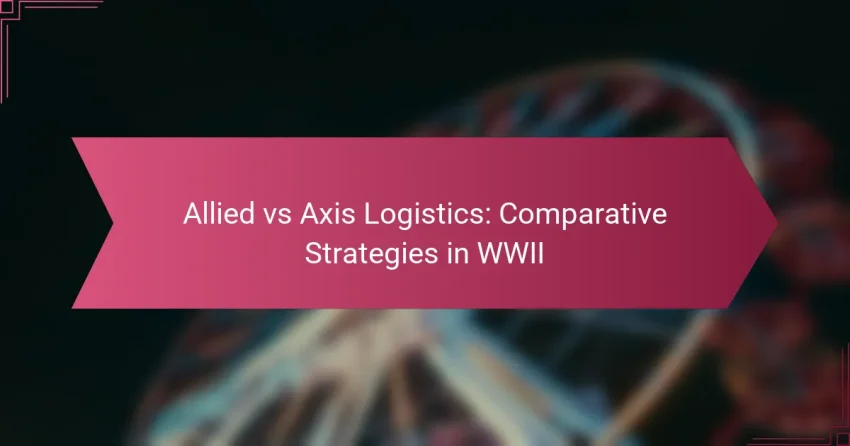During World War II, the logistical strategies of the Allied and Axis forces played a crucial role in determining the outcome of the conflict. The Allies excelled in supply chain management and resource allocation, enabling them to maintain effective military operations across diverse theaters. In contrast, the Axis powers faced significant logistical challenges, including overextended supply lines and limited resources, which hampered their operational effectiveness.

How Did Allied Logistics Outperform Axis Logistics in WWII?
The Allied forces outperformed the Axis in logistics through superior supply chain management, advanced transportation networks, robust resource allocation, and effective communication systems. These factors collectively enabled the Allies to sustain prolonged military campaigns and adapt to changing battlefield conditions more efficiently than their Axis counterparts.
Efficient supply chain management
The Allies implemented a highly organized supply chain that prioritized the timely delivery of essential materials. They utilized a system of depots and forward supply points, allowing for quick distribution of ammunition, food, and medical supplies to frontline troops. This approach minimized delays and ensured that soldiers received what they needed when they needed it.
In contrast, the Axis powers often faced bottlenecks due to less coordinated logistics. Their supply chains were hampered by overextended lines and inadequate infrastructure, leading to shortages that directly impacted combat effectiveness.
Advanced transportation networks
The Allies benefited from well-developed transportation networks, including extensive rail systems and ports capable of handling large volumes of supplies. This infrastructure facilitated rapid movement of troops and equipment across Europe and the Pacific. For instance, the D-Day invasion relied heavily on the efficient use of ports and railways to support the massive influx of Allied forces.
On the other hand, the Axis struggled with transportation challenges, particularly in Eastern Europe, where rail gauges varied and road conditions were often poor. This lack of a cohesive transportation strategy hindered their ability to mobilize resources effectively.
Robust resource allocation
The Allies excelled in resource allocation by leveraging industrial capacity across multiple nations. The United States, for example, ramped up production of war materials through programs like the Lend-Lease Act, which provided crucial support to Allies such as the UK and the Soviet Union. This collaborative approach ensured a steady flow of resources to where they were most needed.
In contrast, the Axis powers often faced resource shortages due to strategic miscalculations and overreliance on specific supply lines. Their inability to adapt to resource constraints limited their operational capabilities and led to critical failures in key battles.
Effective communication systems
The Allies established robust communication systems that facilitated coordination among various military branches and allied nations. Technologies such as radio and encrypted messaging allowed for real-time updates and strategic adjustments on the battlefield. This level of communication was vital for executing complex operations, such as the coordinated attacks during the Normandy landings.
The Axis, however, often struggled with communication breakdowns, which resulted in delayed responses and misaligned strategies. Their reliance on outdated communication methods hindered their ability to adapt quickly to changing combat situations, ultimately impacting their overall effectiveness.

What Key Strategies Did the Allies Use for Logistics?
The Allies employed several key strategies for logistics during World War II, focusing on efficient resource allocation and supply chain management. These strategies were crucial in ensuring that troops received the necessary equipment and supplies to sustain military operations across various theaters of war.
Utilization of Lend-Lease Act
The Lend-Lease Act was a pivotal strategy that allowed the United States to supply Allied nations with military equipment and supplies without immediate payment. This program facilitated the transfer of billions of dollars worth of goods, including vehicles, aircraft, and food, significantly bolstering the war efforts of countries like the United Kingdom and the Soviet Union.
By leveraging the Lend-Lease Act, the Allies could maintain a steady flow of resources, which was essential for sustaining prolonged military campaigns. For example, the provision of American-made tanks and aircraft helped to replenish depleted stocks in critical battles.
Strategic port selection
Strategic port selection played a vital role in the Allies’ logistics, as the choice of ports directly impacted supply chain efficiency. The Allies prioritized ports that could accommodate large volumes of cargo and had the infrastructure to support rapid unloading and distribution of supplies.
Key ports such as Antwerp and Normandy were chosen for their geographical advantages and capacity to facilitate quick access to frontline troops. This careful selection minimized delays and ensured that resources reached the battlefield in a timely manner, which was crucial for operational success.
Decentralized supply bases
The Allies adopted a decentralized approach to supply bases, which allowed for flexibility and responsiveness in logistics operations. By establishing multiple supply depots closer to the front lines, the Allies could reduce transportation times and adapt to changing battlefield conditions.
This strategy also mitigated the risk of supply chain disruptions caused by enemy actions. For instance, having several smaller supply bases instead of one large central depot meant that even if one base was compromised, others could continue to function, ensuring that troops remained well-supplied.

What Were the Major Challenges Faced by Axis Logistics?
The Axis powers encountered significant logistical challenges during World War II that hindered their military effectiveness. Key issues included limited resources, overextended supply lines, and inadequate infrastructure, all of which severely impacted their operational capabilities.
Limited resources and manpower
Axis logistics were severely constrained by limited resources and manpower, particularly as the war progressed. The need for raw materials like oil, steel, and food became increasingly critical, with shortages leading to rationing and prioritization of military needs over civilian supplies.
For instance, Germany faced significant oil shortages by the later years of the war, which hampered tank and aircraft operations. The reliance on occupied territories for resources often resulted in logistical bottlenecks and inefficiencies.
Overextended supply lines
Overextension of supply lines was a major logistical challenge for the Axis powers, particularly on the Eastern Front. As forces advanced deep into Soviet territory, maintaining supply routes became increasingly difficult, leading to delays and shortages.
For example, the German advance into the Soviet Union stretched their supply lines thousands of kilometers, making it hard to deliver necessary supplies like ammunition and fuel. This vulnerability was exploited by Allied forces, who targeted supply routes to disrupt operations.
Inadequate infrastructure
The Axis powers struggled with inadequate infrastructure, which hindered efficient logistics. Many regions occupied by Axis forces lacked the necessary roads, railways, and ports to support large-scale military operations.
In Eastern Europe, the poor condition of roads and rail systems slowed down the movement of troops and supplies. This inadequacy forced the Axis to rely on less efficient transportation methods, further complicating their logistical efforts.

How Did Geography Influence Logistics Strategies?
Geography significantly shaped the logistics strategies of both the Allied and Axis powers during World War II. Factors such as terrain, climate, and the location of supply routes dictated how resources were transported and allocated across various fronts.
Terrain challenges in Europe
Europe’s diverse terrain presented numerous challenges for military logistics. The rugged mountains, dense forests, and extensive river systems complicated the movement of troops and supplies. For instance, the Alps hindered rapid troop movements, while the marshy regions in Eastern Europe slowed down logistical operations.
Allied forces often had to adapt their strategies to navigate these obstacles effectively. They utilized mechanized transport where possible but also relied on rail networks and local resources to overcome difficult terrain. This adaptability was crucial in maintaining supply lines and ensuring operational success.
Strategic location of supply routes
The strategic positioning of supply routes was vital for both sides in the conflict. The Allies focused on securing key ports and rail junctions to facilitate the rapid movement of supplies. For example, the capture of Normandy allowed for a crucial supply line into mainland Europe.
Conversely, the Axis powers often struggled with overextended supply lines, particularly on the Eastern Front. The vast distances and harsh conditions made it challenging to maintain adequate supplies, leading to significant logistical failures. Understanding these strategic locations helped both sides to plan their operations more effectively and to exploit the weaknesses of their opponents.

What Lessons Can Modern Logistics Learn from WWII?
Modern logistics can learn the importance of flexibility and technological integration from the strategies employed during WWII. The ability to adapt to changing circumstances and leverage technology effectively can significantly enhance supply chain efficiency and resilience.
Importance of adaptability
Adaptability was crucial for both the Allied and Axis powers during WWII, as they faced unpredictable challenges. Supply chains had to be adjusted rapidly in response to battlefield conditions, resource availability, and enemy actions. Modern logistics should prioritize flexibility to respond to disruptions, whether from natural disasters or market fluctuations.
Organizations can enhance adaptability by implementing agile methodologies, which allow for quick decision-making and adjustments. For instance, using just-in-time inventory systems can help companies minimize waste and respond swiftly to demand changes, similar to how WWII logistics adapted to shifting front lines.
Value of technology integration
Technology played a pivotal role in logistics during WWII, with advancements in transportation, communication, and data management. The use of trucks, aircraft, and railroads improved the speed and efficiency of supply delivery. Today, integrating technologies like artificial intelligence and real-time tracking can optimize logistics operations and enhance visibility across the supply chain.
Modern logistics should focus on adopting technologies that streamline processes and improve accuracy. For example, using automated inventory management systems can reduce errors and enhance order fulfillment speed. Companies should also consider investing in data analytics to forecast demand and optimize resource allocation, drawing lessons from the technological innovations of the WWII era.

How Did Logistics Impact Key Battles in WWII?
Logistics played a crucial role in determining the outcomes of key battles in WWII by ensuring that troops received the necessary supplies, equipment, and reinforcements. Effective logistical strategies could mean the difference between victory and defeat, as seen in various theaters of war.
Logistics in the Battle of Stalingrad
The Battle of Stalingrad highlighted the importance of logistics in warfare, particularly in urban combat. The Soviet Union’s ability to supply its troops with food, ammunition, and reinforcements, despite harsh winter conditions, was vital for their eventual victory.
German forces, initially well-supplied, faced significant logistical challenges as the battle progressed. Their supply lines were stretched thin, and the encirclement by Soviet troops further exacerbated their difficulties, leading to shortages of essential resources.
Key logistical strategies included the use of railways and the Volga River for transportation. The Soviets effectively utilized these routes to maintain a steady flow of supplies, while the Germans struggled to adapt their logistics to the changing battlefield conditions.
